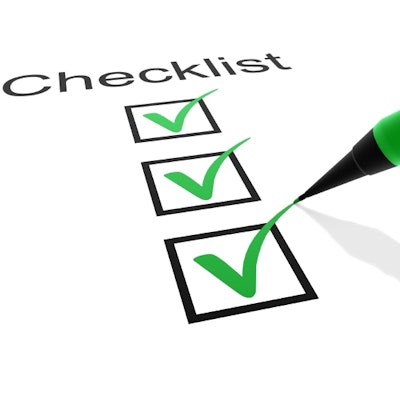
There are many aspects of operation to which a dentist-owner needs to pay attention but also just as many ways to ensure your office runs smoothly and efficiently. One of the best ways to keep your equipment working well and for as long as possible is routine maintenance. Keeping up with routine maintenance is one of the easiest ways to avoid downtime and reduce service calls.
 Rick Zieska.
Rick Zieska.I've compiled a handy list for you and your staff to help ensure nothing is missed. These recommendations are based primarily on manufacturer guidelines and U.S. federal guidelines where applicable. Your local regulations may differ and could require a greater frequency for some items. When in doubt, consult the owner's manual for your specific equipment and the appropriate regulatory body for the issue in question.
7 checklists for routine maintenance
The lists below are not necessarily all-inclusive but cover many things that are frequently overlooked or forgotten. The items on the lists can be delegated to staff members as you see fit. If delegating, provide a checklist with room for comments that the staff member can then return to you when items are completed.
1. Checklist for the beginning of every day
- At the beginning of the day, close the tank drain valve on your compressor. Then turn on the vacuum, compressor, and water. It helps to have a centrally located set of switches for all three components. Allow time for the compressor to build up pressure.
- Confirm data backup was successful and change media if using physical backup and daily generations of media.
- Top off the autoclave reservoir with distilled or deionized water.
- Fill delivery system water bottles with clean fresh water and add a tablet if using a tablet water treatment system. Straw-type systems preclude adding anything to the water.
- Retrieve after-hours voicemails.
- If using a central nitrous system, turn on nitrous and oxygen tanks.
- Fill ultrasonic cleaner with fresh solution.
2. Checklist for the end of every day
- If using a tablet system, remove and cap off water bottles and run an air purge.
- Turn off nitrous and oxygen.
- Empty and rinse out ultrasonic cleaner.
- Clean environmental surfaces with a mild dish-soap and water solution after disinfectant has been in place an appropriate length of time. Examples of surfaces to clean include chair upholstery, operating light lens shields, and delivery system cases. Once disinfectant has been in place long enough to be effective, prolonged exposure can damage surfaces, so it is beneficial to remove disinfectant residue.
- Clean out chairside vacuum traps.
- Flush vacuum lines with cleaner and copious amounts of water.
- Turn off the compressor, vacuum, and water. Open compressor tank drain.
- Turn off the coffee pot.
3. Checklist to perform once per week
- Disassemble and lubricate vacuum valves (high-volume evacuator [HVE] and saliva ejector [SE]) with silicone-based gel lubricant.
- Replace worn chairside vacuum trap screens and inspect trap o-rings and replace if worn.
- Run a spore test on sterilizers. In some areas, this may need to be done more frequently.
- Check amalgam separator(s) fill level and confirm there are no signs of problems, such as clogs.
- Clean sterilizer chamber or sterilizer cassette if using a Statim cassette-type sterilizer using an appropriate solution. Most manufacturers have proprietary solutions.
- Clean and lubricate autoclave door gasket with a mild dish-soap and water solution.
- Drain autoclave reservoir at the end of each week. At the beginning of the week, fill with fresh distilled or deionized water.
- Check autoclave safety valve by pulling on the release ring with pliers. It should spring back when released.
- If using swivel handpieces, remove swivels from hoses and clean and lubricate o-rings with silicone gel lubricant.
- Check tank levels if using nitrous oxide.
4. Checklist to perform once per month
- Inspect nitrous hoses for cracks, damage, or wear and replace if necessary.
- Lubricate operating light and x-ray arm hinges with a basic mineral oil. Just a drop or two of oil should be sufficient.
- Check equipment arms for level.
- Check junction box filters and change if necessary.
- Check plaster trap and empty if necessary.
- Lubricate sterilizer door hinges with high-temperature lube.
5. Checklist to perform quarterly
- Check the emergency oxygen system and automated external defibrillator (AED).
- Pay taxes.
- Check compressor and vacuum filters.
- Check oil on compressor and vacuum if oil-lubricated.
- Restore a computer backup to confirm it is complete. This will also help get you comfortable with the process should you ever need to do so in a real emergency/computer failure.
- Test smoke alarms.
- Check USB connectors and replace patch cords if necessary.
- Lubricate air/water syringe buttons with silicone gel lubricant. Just a dab will do.
6. Checklist to perform twice per year
- Check power cords to all devices for signs of damage. Replace if necessary.
- For some makes and models, check and consider replacement of sterilizer door gasket and door dam.
- Replace Statim cassette seals.
- Remove cover and inspect inside of delivery system, looking for leaks or other problems.
- Check the life of computer universal power supplies.
7. Checklist to perform yearly
- Check fire extinguishers. Many require annual recharging or replacement.
- Change sterilizer door gasket, lubricating with dish-soap and water solution.
- Change sterilizer bellows and filters.
- Change compressor and, if oil-lubricated, the vacuum oil.
- Check x-ray equipment and have it recalibrated and certified if necessary. In most areas this needs to be professionally done once every few years. Confirm where you are in the cycle annually.
- After changing sterilizer components (above), run a sterilizer cycle with the chamber empty and the cover (casing) removed from the sterilizer. Inspect for signs of internal leakage or other issues.
- Change compressor and vacuum filters.
- Change junction box filters.
- Change the amalgam separator cartridge. This may be required more or less frequently. Check the manufacturer's recommendations for your model and always change when full regardless of time interval.
- Clean exterior of central vacuum and compressor of dust, dirt, and debris.
- Test compressor and central vacuum for leaks and proper function. The specifics of how to do so will vary by make and model.
In addition to those items on the lists, try to be observant at all times. Note any odd sounds or smells in addition to any odd things you see. These can often be your first sign that something isn't quite how it should be.
Performing adequate routine maintenance can go a long way toward extending equipment life and reducing equipment failures. By performing the steps above, you can reduce downtime and require fewer service calls.
Rick Zieska has worked for more than 29 years in the dental industry in technical support and management. He has lectured in the U.S. and Canada on equipment repair and maintenance, as well as on many regulations governing equipment use and marketing, including the various standards for amalgam separators. He served as the official correspondent to the U.S. Food and Drug Administration. He is also the president and founder of Dental-TechGuru.com, a site dedicated to educating dental professionals about their equipment.
The comments and observations expressed herein do not necessarily reflect the opinions of DrBicuspid.com, nor should they be construed as an endorsement or admonishment of any particular idea, vendor, or organization.



















